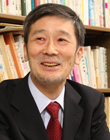The World of Omocha-e
Manabu Tsuzuki
Professor, Faculty of Letters, Chuo University
Area of Specialization: Developmental Psychology
What is Omocha-e?
The three most well-known categories of ukiyo-e (woodblock prints) are yakusha-e (prints of kabuki actors), bijin-ga (prints portraying beautiful women), and fukei-ga (prints depicting landscape scenery). They are often made into special-issue postage stamps. As I write this, I have in my hand a collection titled "Furusato Kitte: Edo Meisho to Iki no Ukiyo-e—Hiroshige, Utamaro, Sharaku no Ni," which roughly translates to "Hometown Postal Stamps: the Fine Ukiyo-e of Famous Places in Edo—Hiroshige, Utamaro, and Sharaku." This is a single-sheet collection of 80-yen postage stamps containing 10 stamps that includes Toshusai Sharaku's "Koshiro Matsumoto IV as Sakanaya Gorobee," Kitagawa Utamaro's "Renowned Beauties Likened to the Six Immortal Poets: Tasumi Roko," and Utagawa Hiroshige's "One Hundred Famous Views of Edo: Plum Park in Kameido" (issued on August 1, 2008).
I'm sure there are many people who became familiar with ukiyo-e through these special-issue postage stamps. I am, in fact, one of them. My curiosity led to a series of events, and now a few years have passed since I started learning about ukiyo-e. Starting in 2016, I was put in charge of the Chuo University Projects on Promoting Educational Power titled "Active Learning through Ukiyo-e Exhibitions," in which I organized ukiyo-e exhibitions together with students. So far, we've held an exhibition for yakusha-e and bijin-ga (2016), and for fukei-ga (2017). The theme of the third ukiyo-e exhibition will be "omocha-e" (toy prints).
Anybody who is familiar with the term omocha-e is most certainly an ukiyo-e expert. Most people will probably be confused upon hearing such a term, not knowing what toys have anything to do with ukiyo-e. I want to take this opportunity to introduce the new ukiyo-e exhibition, and at the same time, talk about the enchanting delight that is omocha-e.
Exhibiting Omocha-e
Compared to yakusha-e, bijin-ga, and fukei-ga, not many works of omocha-e remain today. Why is that? It is because Omocha-e were ukiyo-e that children played with. They're like the supplements that are sometimes included in a children's magazine. These are pieces that can be cut and pasted to make a picture or a toy. They're something children get excited over in anticipation of what they will look like when they're complete. Some children choose magazines based on what supplements are included. The feeling of joy when completing a piece, and the sorrow felt when it breaks—children are engaged in this month's supplements while they look forward to next month's. This is how these supplements were enjoyed, and eventually disposed of. Omocha-e of the past met a similar fate. This is why there are so few of them remaining today.
Omocha-e are ukiyo-e that are meant for play. In that spirit, I would like for the visitors of this exhibit to immerse themselves in play as well. In order to make this happen, we, as the preparers of the exhibition, must also embrace our playful spirit. These are the things the students talked about as we prepared the posters, flyers, and the illustrated book for the event.
The theme that we eventually decided on is "Come! Look! Play!? Ukiyo-e Yokocho: The World of Omocha-e That You've Never Seen." The word yokocho (alley) has a distinct connotation. It invokes images of a great crowd of people bustling through, with voices calling out from shops. It conjures a vibrant scene of people going about their lives. We hope visitors will enjoy our Ukiyo-e Yokocho, a space filled to the brim with a sense of nostalgia and vibrancy. As a way of expressing this sentiment, we designed the following three posters. The illustrations are the same, but the coloring is different for each design. Each of the three depicts morning, day, and night in the yokocho. The paper lanterns of the night-themed poster are intentionally made to look bright, as if beckoning people's hearts toward the yokocho.
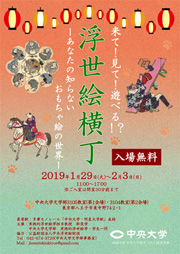
Morning
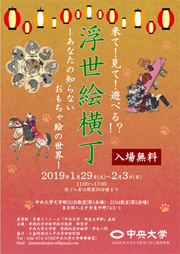
Day
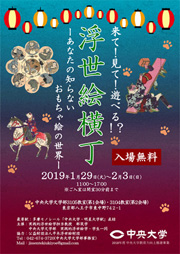
Night
The Structure of the Exhibition
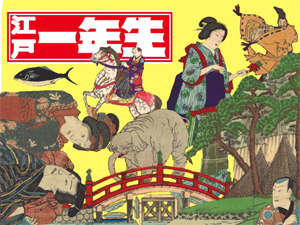
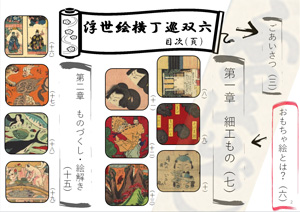
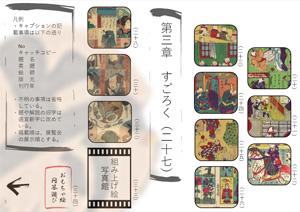
The illustrated book for the exhibition is designed in a creative way that offers the reader a fun way to enjoy omocha-e. It is brimming with playful spirit. The cover is reminiscent of a children's magazine, with a sort of lively and whimsical feel. This is the kind of impression we wanted the book to give. It is titled Edo Ichinensei (Edo First Grader). The illustrations scattered across the cover are all taken from the ukiyo-e that were displayed in the exhibitions. Those with the illustrated book can enjoy finding each of the ukiyo-e on the cover.
The two-page spread containing the table of contents also has a trick that will engage the reader's playful spirit. It is designed as a sugoroku board (a Japanese board game) that travels through Ukiyo-e Yokocho. It starts with the "Greeting" chapter, then continues to "What is Omocha-e?" I'd like to introduce some of what the students wrote.
When you hear about ukiyo-e, do you find it to be difficult to get into, and hard to approach?
Omocha-e are exactly what the name suggests—they're ukiyo-e that were published for children as toys during the Edo and Meiji periods.
None of them were high-quality prints. They were mostly miniatures of plays, illustrated animal encyclopedias, decorative fabrics, and sugoroku boards—mere toys that were cut up, pasted, and played with, meaning that few still exist nowadays.
They are colorful, fun, and vaguely nostalgic. Out of this world of omocha-e, you may see new glimpses of life in the Edo and Meiji eras that we've never seen before.
As described in the table of contents, the exhibition is structured in three parts. The first chapter is titled "Saikumono" (Cut-and-Paste Crafts), the second is called "Monozukushi/Etoki" (Illustrated Encyclopedia/Pictorial Explanations), and the third is called Sugoroku. The exhibition contains a total of 20 pieces of ukiyo-e. Here, I will introduce the following three works of art: a kumiage-e (cut-and-paste crafts), a monozukushi, and sugoroku. We hope you get a sense of this world of omocha-e, which the student above aptly described as "colorful, fun, and vaguely nostalgic."
Kumiage-e
Kumiage-e are similar to paper crafts. You cut along dotted lines to cut out pieces of paper, and fold them in various ways. You arrange them and glue them together. The washi (Japanese paper) on which the ukiyo-e are printed is surprisingly thick. It is thicker than normal copy paper. However, papers are only papers after all. In order to assemble it into a firm structure, it needs strong reinforcement. Completing kumiage-e requires perseverance and dedication. Children would start working on it, be amused at first, but eventually lose interest. Adults would lend them a hand. This might have gotten the adults immersed. You can imagine such scenes playing out.
The largest ukiyo-e is 39 cm in height and 26 cm in width. Putting all the pieces in such a small space is a herculean task. However, completing the task reveals a magnificent Tenman-gu shrine, a satisfying accomplishment. What was going on in the minds of these artists? One can only wonder. This omocha-e is labeled with the ad copy "Box of Tenman-gu Shrine Puzzle." I'd like you to compare this with the illustration of the completed puzzle.
新板箱天神(しんぱんはこてんじん)
Newly published: Box of Tenman-gu shrine
- Artist:
- Utagawa Kuninaga
- Publisher:
- Kawaguchiya Shozo
- Published year:
- Unknown
Box of Tenman-gu Shrine Puzzle
Utagawa Kuninaga was a student of Utagawa Toyokuni I, and was skilled at creating paper models that are crafted by cutting and assembling. This is one of his works.
Once it's assembled, it forms a box-shaped Tenman-gu Shrine, complete with a doll resembling Sugawara no Michizane (a famous scholar, poet and politician from Japan's Heian era). Assembly instructions are written in various places, and at the edge of the illustration is a drawing of the completed shrine and a picture of a box that serves as a hint. However, with so little help, how would you go about assembling this?

Newly Published: Box of Tenman-gu Shrine
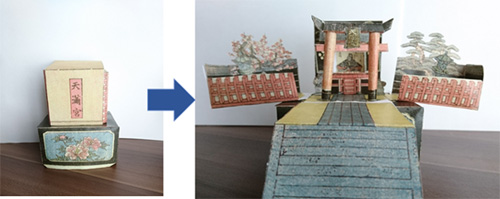
When completed
Monozukushi
Monozukushi are a kind of illustrated encyclopedia. In an age where there were no cameras, copies and sketches served in place of photographs. During the Edo period, herbalists, who observed and recorded plants and animals, created many illustrated reference books. These illustrations were extremely precise, capturing plants and animals in a very lifelike manner. While serious illustrated reference books were expensive and not accessible to the common folk, the monozukushi were more readily available.
The ukiyo-e below is titled Newly Published: Fish Picture Book. The words "Newly Published" in the title refers to the fact that it was printed on a fresh block. Ukiyo-e publishers used to sell new omocha-e after the New Year as a sales strategy. This is how this term came into popular use. They sold them in time for when children received New Year's gifts (usually money given to them by relatives), who were eager to buy omocha-e.
This ukiyo-e is labeled with the ad copy: "Ooh! Look at all the fish!" ("Ooh" sounds similar to the Japanese word for fish, u). Among all the swimming fish depicted in the picture, the red ones are especially brilliant. During the Meiji period, artists began using an aromatic compound called aniline for red print. This is why many of the Meiji period ukiyo-e have brilliant red colors.
Looking at these omocha-e, children may have asked their parents, "What's this fish called?" The parent may have had trouble answering, looking at a fish they've never seen or eaten before. Looking at this picture, you can almost hear the parent-child conversation in this scene.
新板海うをづくし(しんぱんうみうをづくし)
Newly published: Fish picture book
- Artist:
- Utagawa Kunimasa IV
- Publisher:
- Fukase Kamejiro
- Published year:
- Meiji period (1867–1912)
Ooh! Look at all the fish!
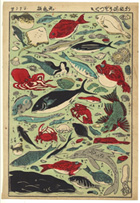
Newly Published: Fish Picture Book
This picture is distinct in that it is totally covered with fish. This fish picture book takes various types of fish and puts it in one place. Looking at these days, you might call it an old fish illustrated encyclopedia. Among the densely packed drawings, you'll even find clams and jellyfish. Each creature is brilliantly colored, and is designed in a way that keeps you fascinated.
And if you look closely, you might even spot a legendary creature! Feast your eyes upon this fascinating work of art!
Sugoroku
The rules of sugoroku, which all Japanese people are familiar with, mostly works like this: You roll the dice, and you move forward the same number of spaces that you rolled. There are spaces that tell you to "stop" and "turn around." You start at the beginning, and the person that reaches the goal first wins. The winner is then out of the game.
In the Edo period, people played this game a little differently. This version is called tobi sugoroku (jumping sugoroku). You roll the dice, and land on a specific space based on the number you have rolled. This differs from the normal version of sugoroku in that it is difficult to win and finish the game. As described in the caption of the ukiyo-e, there are even spaces that you can't land on. You want to finish the game, but you can't quite get there. Once you think you're about to finish, you get knocked back a few space. Tobi sugoroku is, in a way, a metaphor for life itself.
This work, titled "Sugoroku Game of Kabuki Actors," is an exceptionally artistic piece of ukiyo-e created by Utagawa Toyokuni III (Utagawa Kunisada). The sugoroku board features a spectacular arrangement of the famous kabuki actors of the time. It is likely that adults enjoyed this more than children. This is a great example of an omocha-e piece that can be enjoyed even by adults.
踊形容見立寿語六(おどりけいようみたてすごろく)
Sugoroku Game of Kabuki Actors
- Artist:
- Utagawa Toyokuni III (Utagawa Kunisada)
- Publisher:
- Tsujiokaya Bunsuke
- Published year:
- 1855
There are some spaces you can't even land on
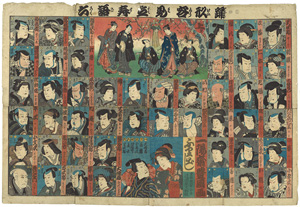
Sugoroku Game of Kabuki Actors
The drawings of successful kabuki actors of 1855 are arranged as spaces along the sugoroku illustration. This type of sugoroku, called tobi sugoroku, is played by moving to a specific grid according to the number rolled on the dice. The surface is designed in a way that allows you to visualize the flow of the game, and as you advance higher, you have more chance to land on grids called jun-nobori that let you advance further, and other grids called jun-jun-nobori that let you advance to jun-nobori. It's designed that the higher up you advance, the more excitement you feel. Jun-nobori and jun-jun-nobori are terms that have been coined to make explaining more convenient.
Enjoying Omocha-e
As we've done in the past, we held the Faculty of Letters extracurricular program called Practical Ukiyo-e Studies again in 2018, and undertook preparations for the exhibition. A total of 15 students participated, including first-year department students and second-year graduate students. Starting in the first term in June, we began studying the fundamentals of ukiyo-e in classroom lectures. In the summer, students visited ukiyo-e exhibitions of their choice, and observed how the exhibitions were organized. On that basis, in the second term, we began making preparations for our own exhibition. The wide-ranging tasks we undertook included divided historical studies of the ukiyo-e; deciding the theme of the exhibition; creating captions for the ukiyo-e; creating flyers, posters, and pamphlets; organizing plans for the exhibition venue, publicizing the event within and outside of the school, and framing ukiyo-e pieces. During the period of the exhibition (including before and after the event), students took part in the construction of the venue, reception and operation, and the dismantling of the venue afterward. Practical Ukiyo-e Studies is centered around the exhibition, with a wide range of activities that surround it. This is a perfect example of active learning.
During the preparatory phase, the prevailing opinion that surfaced was that since this is an omocha-e exhibition, the event should be different from usual. Instead of just framing ukiyo-e and displaying them, we would like visitors to be able to touch and interact with ukiyo-e. The illustrated book should also be different from usual. Also, one classroom would not be enough; two should be used for the venue. The venue should be decorated like a yokocho. These were some of the many ideas that were floated. Creating our own ukiyo-e exhibition is hard work, but it is also very fun. I felt this strongly as we went through the preparations. The more we have fun, the more likely the exhibition is to become enjoyable. We hope that all visitors get to enjoy the wonderful world of omocha-e.
Finally, I'd like to thank three people for making all this possible.
The 20 pieces of ukiyo-e that are displayed at this exhibition were lent to us by the Hiraki Ukiyo-e Foundation. I'd like to give special thanks to the chairman Mitsunobu Sato for his support and cooperation in helping make this exhibition possible. From the same foundation, the chief curator Ms. Yoshino Moriyama and curator Ms. Masako Matsumura provided very valuable instructions for our students throughout all of our ukiyo-e exhibitions. We'd like to thank both of them sincerely.
Ukiyo-e Exhibition
- Theme
- "Come! Look! Play! Ukiyo-e Yokocho: The World of Omocha-e That You've Never Seen"
- Period
- Tuesday, January 29 to Sunday, February 3, 2019, 11 a.m. to 5 p.m.
- Venue
- Chuo University Tama Campus Faculty of Letters Building, Room 3104 and 3105
- Admission: Free
- Manabu Tsuzuki
Professor, Faculty of Letters, Chuo University
Area of Specialization: Developmental Psychology -
Manabu Tsuzuki was born in Tokyo in 1951. He graduated from the Faculty of Education, Tokyo University of Education, and completed the Master's Program in its Graduate School of Education. He completed the Doctoral Program in the Graduate School of Psychology, University of Tsukuba. He has obtained a PhD in education.
He served as a Full-time Lecturer, Assistant Professor at Ogaki Women's College and an Assistant Professor in the Faculty of Letters, Chuo University before assuming his current position in 1994.
He was the Dean of the Chuo University Graduate School of Letters from November 2009 to October 2013, and was the Dean of the Chuo University Faculty of Letters from November 2013 to October 2017.
Research topics
Manabu Tsuzuki has been studying time perspectives since around 1980. Between 1997 and 2011, he used a longitudinal study to explore the process by which time perspectives change along with environmental transitions, publishing his findings. His publications include: University Students' Career Choice and Time Perspective [Daigakusei no Shinro Sentaku to Jikanteki-Tembo] (Nakanishiya Shuppan, 2007); School Transition from Elementary to Junior High School and Time Perspective [Shogakko kara Chugakko e no Gakko Iko to Jikanteki-Tembo] (Nakanishiya Shuppan, 2008); School Transition from Junior High to High School and Time Perspective [Chugakko kara Koko e no Gakko Iko to Jikanteki-Tembo] (Nakanishiya Shuppan, 2009); and High School Students' Career Choice and Time Perspective [Kokosei no Shinro Sentaku to Jikanteki-Tembo] (Nakanishiya Shuppan, 2014).
He published his tenth single-authored work, How to Write a Good Report: A Handbook for First-year University Students [Daigaku Ichinensei no tame no Tsutawaru Repoto no Kakikata] (Yuhikaku Publishing, 2016)
- Research Activities as a Member of Research Fellowship for Young Scientists (DC1), Japan Society for the Promotion of Science (JSPS) Shuma Tsurumi
- Important Factors for Innovation in Payment Services Nobuhiko Sugiura
- Beyond the Concepts of Fellow Citizens and Foreigners— To Achieve SDGs Goal 10 “Reduce Inequality Within and Among Countries” Rika Lee
- Diary of Struggles in Cambodia Fumie Fukuoka
- How Can We Measure Learning Ability?
—Analysis of a Competency Self-Assessment Questionnaire— Yu Saito / Yoko Neha - The Making of the Movie Kirakira Megane

-
Newest Edition 2019 Autumn Issue
Student journalists report on the students’ take of Chuo University

-
Chuo-DNA
The school's history and motto have been passed on to graduates and students alike. Here is a visualization of Chuo University in the future.Core Energy
Launching Chuo University's Knowledge into Action to the rest of the world, like an infinity of sparkling stars scattered throughout space.
Planned by The Yomiuri Shimbun Business Bureau [PR]








